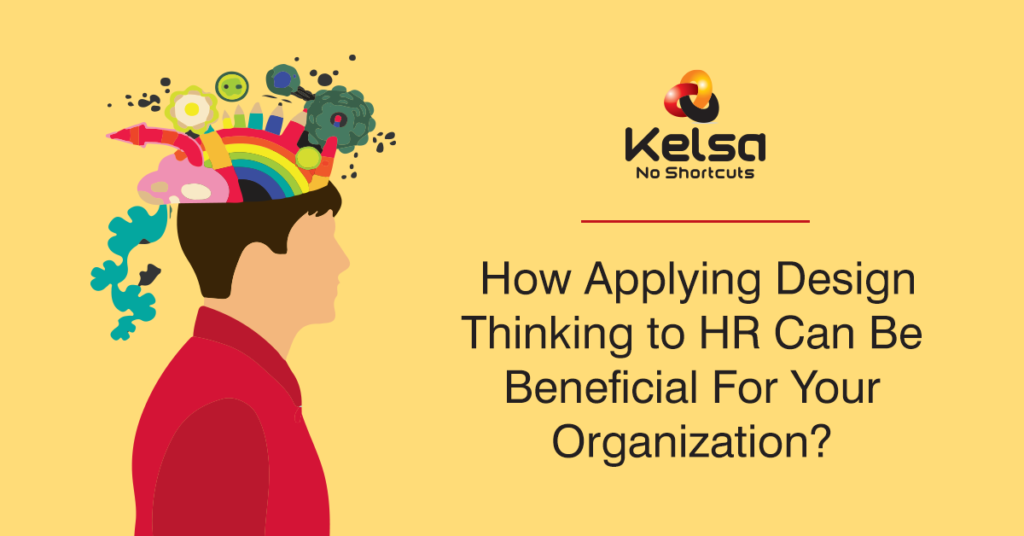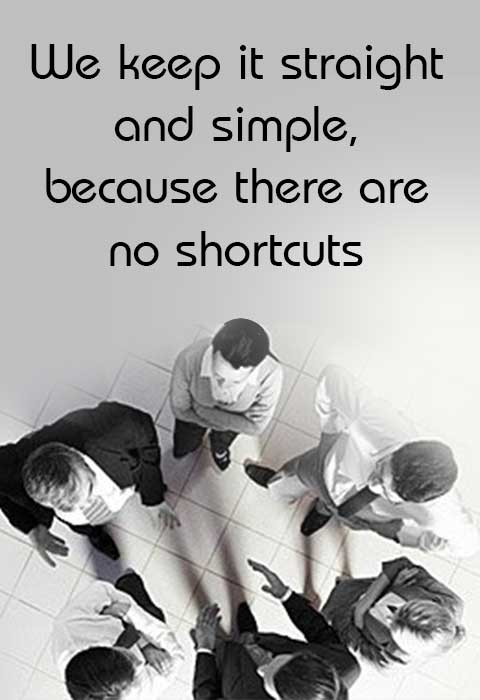How Applying Design Thinking To HR Can Be Beneficial For Your Organization?

Unlike the past, today’s workplaces are intense environments with technology applications driving, monitoring and regulating employees’ everyday routine. And employees are increasingly overwhelmed with the variety of technology applications at play, and the constant flood of information that these generate.
A recent survey by Deloitte revealed that while employees are increasingly connected with their phones to access and direct work-related information, their productivity is “barely rising”. Businesses as well are laden with complexities generated through excessive information, and this is likely hindering their productivity and growth.
Design Thinking makes it easy
Design thinking can help eliminate many of the data and process challenges that businesses face today. At its core, design thinking is focused on simplicity and innovation – and it effectively enables leaders to think beyond the obvious, and look for ideas and solutions that can simplify, deliver and generate delight.
Using design thinking principles also allows HR leaders to place employee experience at the centre and make better sense of their needs at the workplace. These help drive programmes that offer improved solutions eliminate complexity and procedural routine, and foster productivity, enjoyment and connect.
So how do we implement design thinking in HR and drive more meaningful experiences at the workplace? What measures can be taken to ensure effective design thinking? And in what ways have companies utilised the power and potential of design thinking to drive better HR practices?
Broad trends in design thinking at the workplace highlight that HR leaders are currently using the principles to drive
Increased Learning
Several companies are exploiting the central principle of enhanced user experience to drive new and self-directed learning experiences. These allow employees to have greater flexibility, focus and ownership in their learning.
Analytics and Engagement
Design thinking is helping organisations with improved capabilities in data synthesis and analysis. With better quality data at hand companies are building better solutions that directly impact employee connect and engagement. Processes within the workplace are being made easier, efficient and meaningful, and helping employees discover work that is more satisfying and rewarding.
Better Organisation Design
Design-based approaches are helping employers to restructure roles and align teams in such a way that they can drive better efficiencies and quality service delivery outcomes. These enable improved products and services and enhance trust and engagement with customers.
Making digital HR effective
Several organisations are incorporating design thinking principles to create digital HR tools that can be operated within light and easy to use formats. And many more are incorporating them to upgrade and integrate their HR tools with behavioural economics, machine learning and user experience design.
How have companies journeyed through Design Thinking?
To begin with, effective design thinking and implementation is achieved in environments that are not just motivated in driving significant changes to workplace systems and processes, but importantly maintain a strong focus on their PEOPLE.
Integrating the implementation with a deep understanding of human behaviour – what they value, their desires and motivations, and the key drivers that influence their attitude and orientation towards the workplace will be central to its success.
Design thinking has helped Telstra, Australia – one of the leading telecommunications and information services company, to significantly enhance their new employee onboarding experience easily.
The company hires thousands of employees annually who are initially put through a multitude of systems, products and pricing plans to familiarise them with their work. It recently adopted a design based approach to simplify and minimise information complexity and improve the efficacy of its onboarding experience. This was achieved through –
- Discovery interviews that helped leaders to frame the challenges and set clear programme objectives.
- Ethnographic research and data synthesis through detailed interviews and focus group sessions which offered value-rich insights.
- Prototyping through low-fidelity tools that could be tested and refined multiple times, to integrate learnings and insights.
- Personalised blueprints and visualisation that helped define the process within an engaging format, and offered a path to easily emulate the experience.
Journeying through the process has allowed Telstra to launch a highly revitalised onboarding experience that is personalised, encourages active learning and participation, and celebrates growth and contribution. The company has now extended design thinking approaches to drive change management, leadership development, enhance HR services experience and employee development programmes.
Beginning the Design Thinking journey
Successful HR leaders know that they need to invest in strong foundations to foster robust design thinking capabilities within their teams. These will include –
- Investing in human centred designDeveloping a more intimate relationship with their workforce, and engaging with them closer both in and out of the workplace, to develop deep insights and enable high impact programmes and solutions.
- Aligning closer with customer servicesWorking closer with and observing customer interfacing units – for instance, retail teams and units, and transferring insights and learnings into effective HR design.
- Developing prototypes that help to test and learnNew programmes can be easily prototyped within small groups in test environments, and enable HR to tailor programmes that offer end-to-end employee experience.
How Applying Design Thinking To HR Can Be Beneficial For Your Organization?

Unlike the past, today’s workplaces are intense environments with technology applications driving, monitoring and regulating employees’ everyday routine. And employees are increasingly overwhelmed with the variety of technology applications at play, and the constant flood of information that these generate.
A recent survey by Deloitte revealed that while employees are increasingly connected with their phones to access and direct work-related information, their productivity is “barely rising”. Businesses as well are laden with complexities generated through excessive information, and this is likely hindering their productivity and growth.
Design Thinking makes it easy
Design thinking can help eliminate many of the data and process challenges that businesses face today. At its core, design thinking is focused on simplicity and innovation – and it effectively enables leaders to think beyond the obvious, and look for ideas and solutions that can simplify, deliver and generate delight.
Using design thinking principles also allows HR leaders to place employee experience at the centre and make better sense of their needs at the workplace. These help drive programmes that offer improved solutions eliminate complexity and procedural routine, and foster productivity, enjoyment and connect.
So how do we implement design thinking in HR and drive more meaningful experiences at the workplace? What measures can be taken to ensure effective design thinking? And in what ways have companies utilised the power and potential of design thinking to drive better HR practices?
Broad trends in design thinking at the workplace highlight that HR leaders are currently using the principles to drive
Increased Learning
Several companies are exploiting the central principle of enhanced user experience to drive new and self-directed learning experiences. These allow employees to have greater flexibility, focus and ownership in their learning.
Analytics and Engagement
Design thinking is helping organisations with improved capabilities in data synthesis and analysis. With better quality data at hand companies are building better solutions that directly impact employee connect and engagement. Processes within the workplace are being made easier, efficient and meaningful, and helping employees discover work that is more satisfying and rewarding.
Better Organisation Design
Design-based approaches are helping employers to restructure roles and align teams in such a way that they can drive better efficiencies and quality service delivery outcomes. These enable improved products and services and enhance trust and engagement with customers.
Making digital HR effective
Several organisations are incorporating design thinking principles to create digital HR tools that can be operated within light and easy to use formats. And many more are incorporating them to upgrade and integrate their HR tools with behavioural economics, machine learning and user experience design.
How have companies journeyed through Design Thinking?
To begin with, effective design thinking and implementation is achieved in environments that are not just motivated in driving significant changes to workplace systems and processes, but importantly maintain a strong focus on their PEOPLE.
Integrating the implementation with a deep understanding of human behaviour – what they value, their desires and motivations, and the key drivers that influence their attitude and orientation towards the workplace will be central to its success.
Design thinking has helped Telstra, Australia – one of the leading telecommunications and information services company, to significantly enhance their new employee onboarding experience easily.
The company hires thousands of employees annually who are initially put through a multitude of systems, products and pricing plans to familiarise them with their work. It recently adopted a design based approach to simplify and minimise information complexity and improve the efficacy of its onboarding experience. This was achieved through –
- Discovery interviews that helped leaders to frame the challenges and set clear programme objectives.
- Ethnographic research and data synthesis through detailed interviews and focus group sessions which offered value-rich insights.
- Prototyping through low-fidelity tools that could be tested and refined multiple times, to integrate learnings and insights.
- Personalised blueprints and visualisation that helped define the process within an engaging format, and offered a path to easily emulate the experience.
Journeying through the process has allowed Telstra to launch a highly revitalised onboarding experience that is personalised, encourages active learning and participation, and celebrates growth and contribution. The company has now extended design thinking approaches to drive change management, leadership development, enhance HR services experience and employee development programmes.
Beginning the Design Thinking journey
Successful HR leaders know that they need to invest in strong foundations to foster robust design thinking capabilities within their teams. These will include –
- Investing in human centred designDeveloping a more intimate relationship with their workforce, and engaging with them closer both in and out of the workplace, to develop deep insights and enable high impact programmes and solutions.
- Aligning closer with customer servicesWorking closer with and observing customer interfacing units – for instance, retail teams and units, and transferring insights and learnings into effective HR design.
- Developing prototypes that help to test and learnNew programmes can be easily prototyped within small groups in test environments, and enable HR to tailor programmes that offer end-to-end employee experience.




